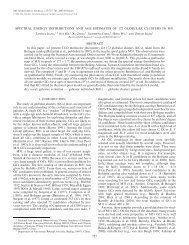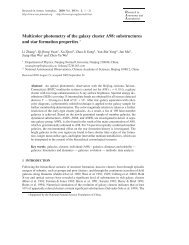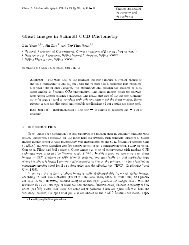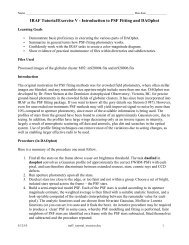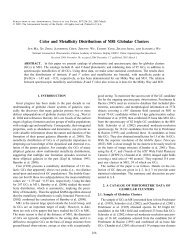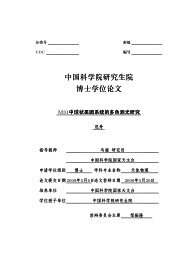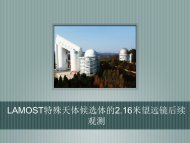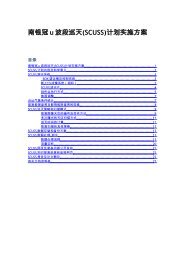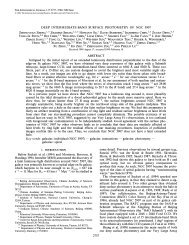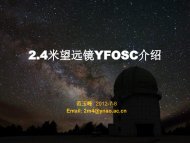Wu,H.,Deng,Z.G.,Chen,J.S.,Zhou,X.,et al,2002 ... - BATC home page
Wu,H.,Deng,Z.G.,Chen,J.S.,Zhou,X.,et al,2002 ... - BATC home page
Wu,H.,Deng,Z.G.,Chen,J.S.,Zhou,X.,et al,2002 ... - BATC home page
Create successful ePaper yourself
Turn your PDF publications into a flip-book with our unique Google optimized e-Paper software.
PHOTOMETRY OF NGC 4565 1365<br />
sky-background levels. Infrared J, H, and K imaging by<br />
Rice (1996, hereafter R96) compl<strong>et</strong>es the existing photom<strong>et</strong>ric<br />
imaging data on this g<strong>al</strong>axy.<br />
Our observations and the d<strong>et</strong>ails of our reduction of the<br />
data that we have obtained for NGC 4565 are given in x 2.<br />
The measurement of the luminosity profiles and error an<strong>al</strong>ysis<br />
are presented in x 3. Section 4 gives the results of model<br />
fitting, comparison, and possible systematic effects from the<br />
point-spread function (PSF) and disk inclination. The last<br />
section summarizes the main results of this paper.<br />
2. OBSERVATIONS AND DATA REDUCTION<br />
2.1. Observations<br />
Observations of NGC 4565 were obtained with the 60/90<br />
cm Schmidt telescope at the Xinglong Station of the<br />
Nation<strong>al</strong> Astronomy Observatories of China, using a thick<br />
Ford 2048 2048 CCD with 15 lm pixels at the f/3 prime<br />
focus. The field of view of this CCD is 58 0 58 0 and the sc<strong>al</strong>e<br />
is 1>7 pixel 1 . With the nearly 1 field of view, there is sufficient<br />
sky in a single frame such that objects with visu<strong>al</strong> sizes<br />
less than 30 0 can have their sky background d<strong>et</strong>ermined<br />
accurately. The Lick data-taking system is employed, and<br />
<strong>al</strong>l the CCD images are overscan subtracted (i.e., initi<strong>al</strong>ly<br />
bias subtracted) during the readout time (Zheng <strong>et</strong> <strong>al</strong>. 1999).<br />
The filter used for the observations reported here is the<br />
<strong>BATC</strong> filter with a centr<strong>al</strong> wavelength of 6660 Å and bandwidth<br />
of 480 Å (Fan <strong>et</strong> <strong>al</strong>. 1996; Yan <strong>et</strong> <strong>al</strong>. 2000). This filter<br />
is a good compromise b<strong>et</strong>ween g<strong>et</strong>ting as far to the red as<br />
possible and avoiding many bright sky emission lines with<br />
the broadest possible filter. Indeed, <strong>al</strong>l of the <strong>BATC</strong> filters<br />
are designed to avoid contamination by emission lines from<br />
the night sky (see Fan <strong>et</strong> <strong>al</strong>. 1996).<br />
We obtained 190 images of NGC 4565 from 1995 to 1997,<br />
of which we deemed 150 images taken in 22 runs (Table 1)<br />
as suitable for an<strong>al</strong>ysis. Most of these images are of exposure<br />
times 900–1200 s. In a given night, <strong>al</strong>l exposures were<br />
dithered randomly at a level of 10 pixels to facilitate<br />
remov<strong>al</strong> of cosmic rays and CCD defects during the data<br />
reduction. The n<strong>et</strong> effect of such dithering is to reduce the<br />
full exposure field of view to less than the full field of the<br />
CCD. All images used in this an<strong>al</strong>ysis have FWHM seeings<br />
b<strong>et</strong>ween 1.7 and 2.6 pixels, or 2>9–4>4, somewhat larger<br />
than the typic<strong>al</strong> seeing at the Xinglong observing station.<br />
During the observations the gain of the CCD system was<br />
adjusted sever<strong>al</strong> times (for various reasons owing to having<br />
the CCD system work well), resulting in gains of 3.7 e<br />
ADU 1 in 1995, 4.1 e ADU 1 in 1996, and 3.3 e ADU 1<br />
in 1997. Readout noise was constant (12 e ) during the three<br />
years.<br />
2.2. Bias and Dark<br />
The mean v<strong>al</strong>ue of the overscan-subtracted bias was stable<br />
within any 1 month period of time. Ten bias frames (five<br />
at the start of the night, five at the end) are taken daily for<br />
the <strong>BATC</strong> program. Since we can track the stability of the<br />
bias during the year, we are able to average from 200 to 300<br />
individu<strong>al</strong> bias frames for each night of observation, which<br />
removes any stable structure in the bias frame (any variable<br />
level is removed via the overscan subtraction). It is this average<br />
of many bias frames that is subtracted from the images<br />
of a given night. The CCD dark count has been constantly<br />
monitored throughout the <strong>BATC</strong> survey and has <strong>al</strong>ways<br />
TABLE 1<br />
Brief Observation Log of NGC 4565<br />
Date N a (s)<br />
Exposure Time b<br />
Gain<br />
(e ADU 1 )<br />
1995 Jan 28 ........ 1 1800 3.7<br />
1995 Mar 3......... 8 9600 3.7<br />
1995 Mar 4......... 2 1800 3.7<br />
1995 May 5 ........ 2 2400 3.7<br />
1995 May 6 ........ 7 6623 3.7<br />
1995 May 24....... 4 3720 3.7<br />
1996 Jan 21 ........ 4 4800 4.1<br />
1996 Feb 17........ 17 15300 4.1<br />
1996 Feb 18........ 20 18000 4.1<br />
1996 Feb 19........ 20 18000 4.1<br />
1996 Feb 20........ 16 14400 4.1<br />
1996 Feb 21........ 4 3600 4.1<br />
1997 Mar 15 ....... 4 4800 3.3<br />
1997 Mar 29 ....... 3 3600 3.3<br />
1997 Mar 30 ....... 1 1200 3.3<br />
1997 Apr 4 ......... 4 4800 3.3<br />
1997 Apr 5 ......... 6 7200 3.3<br />
1997 Apr 8 ......... 5 6000 3.3<br />
1997 Apr 9 ......... 7 8400 3.3<br />
1997 Apr 10........ 5 6000 3.3<br />
1997 Apr 11........ 6 7200 3.3<br />
1997 May 28....... 4 4800 3.3<br />
Tot<strong>al</strong>.................. 150 154043<br />
a Numbers of frames observed.<br />
b Tot<strong>al</strong> exposure time in one night.<br />
been found to be stable and rather free of gradients. As the<br />
average dark count per pixel is 3 e hr 1 , the dark-count<br />
level in a 42.8 hr exposure is 128 e pixel 1 , or 0.04% of the<br />
sky level in this combined image, and the spati<strong>al</strong> variation<br />
of dark is even sm<strong>al</strong>ler, i.e., of negligible importance. This<br />
constant dark-count v<strong>al</strong>ue was sc<strong>al</strong>ed to exposure time for<br />
each image, then subtracted.<br />
2.3. Flat Field<br />
As d<strong>et</strong>ailed in our previous papers (see Fan <strong>et</strong> <strong>al</strong>. 1996;<br />
Zheng <strong>et</strong> <strong>al</strong>. 1999), the <strong>BATC</strong> program has developed the<br />
means by which we can use dome flats to obtain accurate,<br />
high sign<strong>al</strong>-to-noise (S/N), flat fields for flat-fielding sky<br />
images. Briefly, the Xinglong Schmidt telescope is equipped<br />
with a UV-transparent plastic diffuser plate that can be<br />
firmly placed directly in front of the Schmidt corrector. The<br />
diffuser provides randomly scattered light to the corrector,<br />
reproducing the flux from a uniform sky. Such a m<strong>et</strong>hod is<br />
necessary to accurately flat-field our images, since Wild<br />
(1997) points out that over a 1 sc<strong>al</strong>e, no part of the sky is<br />
re<strong>al</strong>ly flat. Addition<strong>al</strong>ly, this fact is attested to by the many<br />
<strong>BATC</strong> images our survey has obtained. We note, however,<br />
that it is only with narrow- or intermediate-band filters that<br />
this diffuser on a Schmidt telescope can produce reliable flat<br />
fields. Otherwise, the dome flat field can introduce secondorder<br />
color terms to broadband observations that must be<br />
removed using direct sky images (Fan <strong>et</strong> <strong>al</strong>. 1996).<br />
We take 12 dome flats each day, each with exposure times<br />
of 150 s. This length of exposure reduces the effect of the<br />
finite time for shutter opening and closing, resulting in a<br />
spurious gradient of less than 0.013% (see x 3.3). All 12<br />
dome flats in 1 day are combined as the fin<strong>al</strong> flat field to correct<br />
the frames obtained on the same night. The tot<strong>al</strong> count




